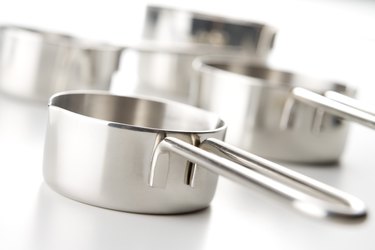
Two of the most popular materials for sauce pans, skillets and saute pans are stainless steel and hard anodized aluminum. Because stainless steel is a poor heat conductor, many manufacturers make tri-ply cookware with an inner layer of aluminum sandwiched between two layers of stainless steel. Stainless steel tri-ply pans and hard anodized aluminum pans vary in price and, depending on your preferences, you may choose a matched set or different materials for different pans.
Appearance
Video of the Day
Stainless steel tri-ply cookware is made of stainless steel with a layer of either copper or aluminum sandwiched between the base layers of the pot or pan. The outside surface is shiny and reflective. Hard anodized aluminum is aluminum that has been treated to make it last longer and keep it from reacting to acidic foods, and it is very dark and matte in appearance. Some home cooks prefer the sleek look of stainless steel.
Video of the Day
Use
Stainless steel tri-ply and hard anodized aluminum can be used interchangeably. Both are good choices for skillets and other pans used to saute or fry food, and both are fairly lightweight, especially when compared to copper or cast iron. When cooking with hard anodized aluminum, be sure to preheat the pan for a minute or two before adding oil or another fat. Stainless steel tri-ply should be coated with oil or fat before heating. Both materials can be used on electric, gas or induction stoves. Neither are non-stick, but hard anodized cookware may be purchased with a non-stick coating.
Cleaning and Care
Hard anodized aluminum pans should always be washed by hand. Use hot, soapy water and a nylon scrub or mild sponge. You can also use a specialty cleanser, such as Bar Keeper's Friend, on hard anodized aluminum. Difficult stains can be treated by filling the pan with water and 1/4 cup of white vinegar and allowing the mixture to boil for ten minutes. Stainless steel tri-ply may or may not be dishwasher safe, depending on the manufacturer's instructions. Hot soapy water will clean most stainless steel tri-ply. Difficult spots can be treated with fresh lemon juice or a paste of water mixed with a cleanser such as Bar Keeper's Friend.
Cost
Stainless steel tri-ply with a copper lining is the most expensive type of tri-ply cookware, while stainless steel tri-ply with an aluminum lining is usually less expensive. Hard anodized aluminum is less expensive than stainless steel tri-ply and, next to non-anodized aluminum, usually the most economical choice when shopping for pots and pans.